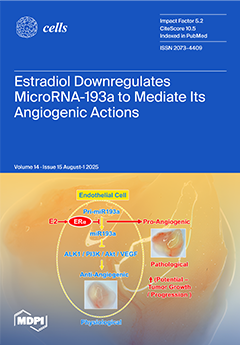Skeletal muscle development is a critical economic trait in livestock, governed by myogenic satellite cell regulation. Integrins mediate mechanical anchorage to the ECM and enable ECM–intracellular signaling.
CIB2, as an EF-hand-domain protein involved in mechanotransduction, shows significant developmental regulation in goat muscle.
[...] Read more.
Skeletal muscle development is a critical economic trait in livestock, governed by myogenic satellite cell regulation. Integrins mediate mechanical anchorage to the ECM and enable ECM–intracellular signaling.
CIB2, as an EF-hand-domain protein involved in mechanotransduction, shows significant developmental regulation in goat muscle. Although the role of
CIB2 in skeletal muscle growth is poorly characterized, we observed pronounced developmental upregulation of
IB2 in postnatal goat muscle.
CIB2 expression increased >20-fold by postnatal day 90 (P90) compared to P1, sustaining elevation through P180 (
p < 0.05). Functional investigations indicated that siRNA-mediated knockdown of
CIB2 could inhibit myoblast proliferation by inducing S-phase arrest (
p < 0.05) and downregulating the expression of
CDK4/
Cyclin D/
E. Simultaneously,
CIB2 interference treatment was found to decrease the proliferative activity of goat myogenic satellite cells, yet it significantly promoted differentiation by upregulating the expression of
MyoD/
MyoG/
MyHC (
p < 0.01). Mechanistically,
CTCF was identified as a transcriptional repressor binding to an intragenic region of the
CIB2 gene locus (ChIP enrichment: 2.3-fold,
p < 0.05). Knockdown of
CTCF induced upregulation of
CIB2 (
p < 0.05). RNA-seq analysis established
CIB2 as a calcium signaling hub: its interference activated IL-17/TNF and complement cascades, while overexpression suppressed focal adhesion/ECM–receptor interactions and enriched neuroendocrine pathways. Collectively, this study identifies the CTCF-CIB2–integrin α7β1–PI3K/AKT axis as a novel molecular mechanism that regulates the balance of myogenic fate in goats. These findings offer promising targets for genomic selection and precision breeding strategies aimed at enhancing muscle productivity in ruminants.
Full article






